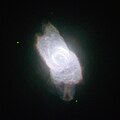پرونده:NGC 6572.jpg
NGC_6572.jpg (۵۰۰ × ۵۰۰ پیکسل، اندازهٔ پرونده: ۱۳۵ کیلوبایت، نوع MIME پرونده: image/jpeg)
تاریخچهٔ پرونده
روی تاریخ/زمانها کلیک کنید تا نسخهٔ مربوط به آن هنگام را ببینید.
| تاریخ/زمان | بندانگشتی | ابعاد | کاربر | توضیح | |
|---|---|---|---|---|---|
| کنونی | ۱۴ دسامبر ۲۰۱۰، ساعت ۱۷:۰۸ |  | ۵۰۰ در ۵۰۰ (۱۳۵ کیلوبایت) | Antonsusi | Better jpg-quality, less environment of no interest |
| ۱۳ دسامبر ۲۰۱۰، ساعت ۱۴:۵۹ |  | ۶۲۹ در ۶۳۸ (۶۸ کیلوبایت) | Jmencisom | {{Information |Description={{en|1=The NASA/ESA Hubble Space Telescope has turned its eagle eye to the planetary nebula NGC 6572, a very bright example of these strange but beautiful objects. Planetary nebulae are created during the late stages of the evol |
کاربرد پرونده
صفحهٔ زیر از این تصویر استفاده میکند:
کاربرد سراسری پرونده
ویکیهای دیگر زیر از این پرونده استفاده میکنند:
- کاربرد در ar.wikipedia.org
- کاربرد در az.wikipedia.org
- کاربرد در be.wikipedia.org
- کاربرد در ce.wikipedia.org
- کاربرد در cs.wikipedia.org
- کاربرد در de.wikipedia.org
- کاربرد در diq.wikipedia.org
- کاربرد در en.wikipedia.org
- کاربرد در fr.wikipedia.org
- کاربرد در hr.wikipedia.org
- کاربرد در it.wikipedia.org
- کاربرد در it.wikibooks.org
- کاربرد در kk.wikipedia.org
- کاربرد در mk.wikipedia.org
- کاربرد در nl.wikipedia.org
- کاربرد در pl.wikipedia.org
- کاربرد در pt.wikipedia.org
- کاربرد در ru.wikipedia.org
- کاربرد در sk.wikipedia.org
- کاربرد در tr.wikipedia.org
- کاربرد در tt.wikipedia.org
- کاربرد در www.wikidata.org
- کاربرد در zh.wikipedia.org

